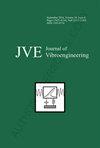Effect of excitation vibration on mechanical property and stress corrosion resistance of cast steel
IF 0.9
Q4 ENGINEERING, MECHANICAL
引用次数: 0
Abstract
Cast steel parts can realize rapid prototyping effectively, which is suitable for complex structural design. However, due to the large residual stress, the problem of mechanical property degradation is more obvious. In order to solve this problem, a high temperature excitation vibration treatment scheme is proposed in this paper. By applying different excitation frequencies and impact forces, the effects of mechanical properties and stress corrosion properties are studied and verified. Based on the finite element software ANSYS, the modal shape and resonant frequency of the cast steel parts are obtained, and verified by the sweep frequency module in the excitation vibration system. According to the characteristics of modal shape, five typical detection paths are set, and stress sensors are arranged every 200 mm. In order to obtain the specific effects of excitation frequency and impact force amplitude on mechanical properties, nine parts samples were prepared on the same production line according to the matching requirements of test parameters. In addition, the main external parameters that remain unchanged during vibration excitation are set as initial 750 ℃ and vibration excitation time of 60 s, which can fully affect the effect of austenite transformation. Keeping the synchronization of test parameters in different samples, the distribution rules of residual stress under different excitation frequencies and forces are obtained and analyzed. In the aspect of mechanical properties, the microstructure, hardness, yield strength and tensile strength of the specimens subjected to vibration were compared and analyzed. In the aspect of stress corrosion performance research, stress corrosion cracking test was carried out in weak acid environment to obtain the tensile stress curve and fracture morphology of the specimen. The results show that the excitation vibration at high temperature can effectively eliminate the residual stress of cast steel parts, but the increase of excitation frequency does not correspond to the effect of residual stress elimination. When the exciting force exceeds a certain value, the stress relief effect cannot be further improved. Excitation vibration can reduce the internal hardness of cast steel parts to a certain extent, and improve the yield strength and tensile strength. At the same time, it has a positive role in promoting the improvement of stress corrosion resistance.激振对铸钢力学性能和抗应力腐蚀性能的影响
铸钢件可以有效地实现快速成型,适用于复杂的结构设计。然而,由于残余应力较大,力学性能退化的问题更加明显。为了解决这一问题,本文提出了一种高温激振处理方案。通过施加不同的激励频率和冲击力,研究和验证了机械性能和应力腐蚀性能的影响。基于有限元软件ANSYS,得到了铸钢件的模态形状和共振频率,并通过激振系统中的扫频模块进行了验证。根据模态形状的特点,设置了五个典型的检测路径,每200mm布置一个应力传感器。为了获得激励频率和冲击力振幅对机械性能的具体影响,根据测试参数的匹配要求,在同一条生产线上制备了九个零件样品。此外,激振过程中保持不变的主要外部参数设置为初始750℃和激振时间60s,这可以充分影响奥氏体转变的效果。在保持不同样品试验参数同步的情况下,获得并分析了不同激励频率和激励力下残余应力的分布规律。在力学性能方面,对振动试样的微观结构、硬度、屈服强度和抗拉强度进行了比较分析。在应力腐蚀性能研究方面,在弱酸环境下进行了应力腐蚀开裂试验,得到了试样的拉应力曲线和断裂形态。结果表明,高温激振能有效消除铸钢件的残余应力,但激振频率的增加与消除残余应力的效果不一致。当激振力超过一定值时,应力消除效果无法进一步提高。激振可以在一定程度上降低铸钢件的内部硬度,提高屈服强度和抗拉强度。同时,对提高应力腐蚀抗力具有积极的促进作用。
本文章由计算机程序翻译,如有差异,请以英文原文为准。
求助全文
约1分钟内获得全文
求助全文
来源期刊

Journal of Vibroengineering
工程技术-工程:机械
CiteScore
1.70
自引率
0.00%
发文量
97
审稿时长
4.5 months
期刊介绍:
Journal of VIBROENGINEERING (JVE) ISSN 1392-8716 is a prestigious peer reviewed International Journal specializing in theoretical and practical aspects of Vibration Engineering. It is indexed in ESCI and other major databases. Published every 1.5 months (8 times yearly), the journal attracts attention from the International Engineering Community.
 求助内容:
求助内容: 应助结果提醒方式:
应助结果提醒方式:


